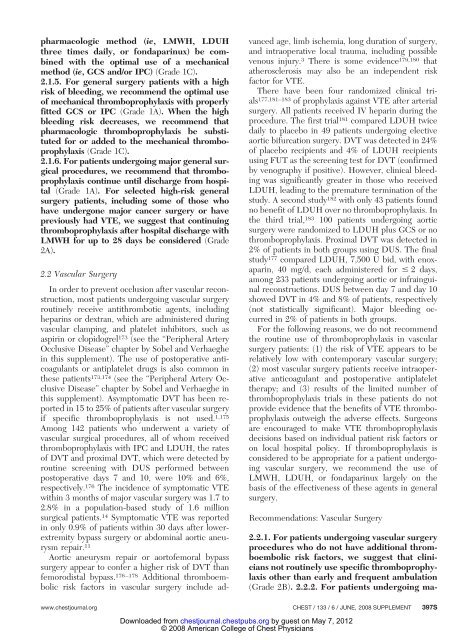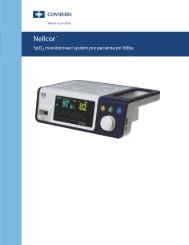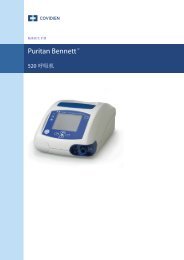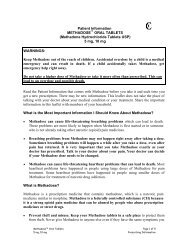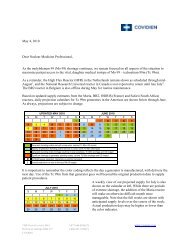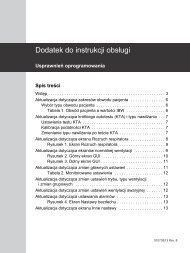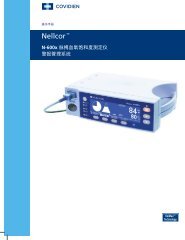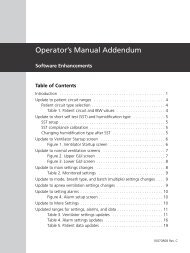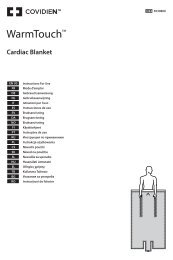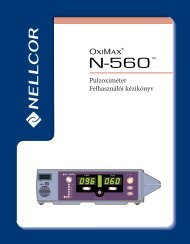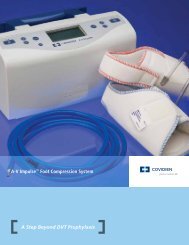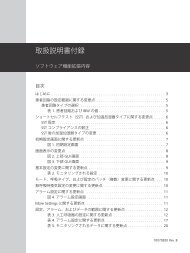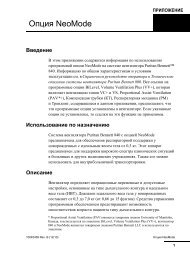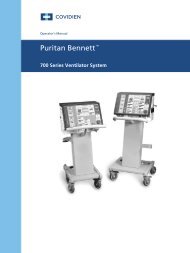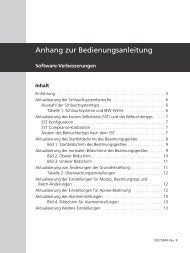Prevention of Venous Thromboembolism - Covidien
Prevention of Venous Thromboembolism - Covidien
Prevention of Venous Thromboembolism - Covidien
You also want an ePaper? Increase the reach of your titles
YUMPU automatically turns print PDFs into web optimized ePapers that Google loves.
pharmacologic method (ie, LMWH, LDUH<br />
three times daily, or fondaparinux) be combined<br />
with the optimal use <strong>of</strong> a mechanical<br />
method (ie, GCS and/or IPC) (Grade 1C).<br />
2.1.5. For general surgery patients with a high<br />
risk <strong>of</strong> bleeding, we recommend the optimal use<br />
<strong>of</strong> mechanical thromboprophylaxis with properly<br />
fitted GCS or IPC (Grade 1A). When the high<br />
bleeding risk decreases, we recommend that<br />
pharmacologic thromboprophylaxis be substituted<br />
for or added to the mechanical thromboprophylaxis<br />
(Grade 1C).<br />
2.1.6. For patients undergoing major general surgical<br />
procedures, we recommend that thromboprophylaxis<br />
continue until discharge from hospital<br />
(Grade 1A). For selected high-risk general<br />
surgery patients, including some <strong>of</strong> those who<br />
have undergone major cancer surgery or have<br />
previously had VTE, we suggest that continuing<br />
thromboprophylaxis after hospital discharge with<br />
LMWH for up to 28 days be considered (Grade<br />
2A).<br />
2.2 Vascular Surgery<br />
In order to prevent occlusion after vascular reconstruction,<br />
most patients undergoing vascular surgery<br />
routinely receive antithrombotic agents, including<br />
heparins or dextran, which are administered during<br />
vascular clamping, and platelet inhibitors, such as<br />
aspirin or clopidogrel173 (see the “Peripheral Artery<br />
Occlusive Disease” chapter by Sobel and Verhaeghe<br />
in this supplement). The use <strong>of</strong> postoperative anticoagulants<br />
or antiplatelet drugs is also common in<br />
these patients173,174 (see the “Peripheral Artery Occlusive<br />
Disease” chapter by Sobel and Verhaeghe in<br />
this supplement). Asymptomatic DVT has been reported<br />
in 15 to 25% <strong>of</strong> patients after vascular surgery<br />
if specific thromboprophylaxis is not used. 1,175<br />
Among 142 patients who underwent a variety <strong>of</strong><br />
vascular surgical procedures, all <strong>of</strong> whom received<br />
thromboprophylaxis with IPC and LDUH, the rates<br />
<strong>of</strong> DVT and proximal DVT, which were detected by<br />
routine screening with DUS performed between<br />
postoperative days 7 and 10, were 10% and 6%,<br />
respectively. 176 The incidence <strong>of</strong> symptomatic VTE<br />
within 3 months <strong>of</strong> major vascular surgery was 1.7 to<br />
2.8% in a population-based study <strong>of</strong> 1.6 million<br />
surgical patients. 14 Symptomatic VTE was reported<br />
in only 0.9% <strong>of</strong> patients within 30 days after lowerextremity<br />
bypass surgery or abdominal aortic aneurysm<br />
repair. 11<br />
Aortic aneurysm repair or aort<strong>of</strong>emoral bypass<br />
surgery appear to confer a higher risk <strong>of</strong> DVT than<br />
femorodistal bypass. 176–178 Additional thromboembolic<br />
risk factors in vascular surgery include ad-<br />
vanced age, limb ischemia, long duration <strong>of</strong> surgery,<br />
and intraoperative local trauma, including possible<br />
venous injury. 3 There is some evidence 179,180 that<br />
atherosclerosis may also be an independent risk<br />
factor for VTE.<br />
There have been four randomized clinical trials<br />
177,181–183 <strong>of</strong> prophylaxis against VTE after arterial<br />
surgery. All patients received IV heparin during the<br />
procedure. The first trial 181 compared LDUH twice<br />
daily to placebo in 49 patients undergoing elective<br />
aortic bifurcation surgery. DVT was detected in 24%<br />
<strong>of</strong> placebo recipients and 4% <strong>of</strong> LDUH recipients<br />
using FUT as the screening test for DVT (confirmed<br />
by venography if positive). However, clinical bleeding<br />
was significantly greater in those who received<br />
LDUH, leading to the premature termination <strong>of</strong> the<br />
study. A second study 182 with only 43 patients found<br />
no benefit <strong>of</strong> LDUH over no thromboprophylaxis. In<br />
the third trial, 183 100 patients undergoing aortic<br />
surgery were randomized to LDUH plus GCS or no<br />
thromboprophylaxis. Proximal DVT was detected in<br />
2% <strong>of</strong> patients in both groups using DUS. The final<br />
study 177 compared LDUH, 7,500 U bid, with enoxaparin,<br />
40 mg/d, each administered for � 2 days,<br />
among 233 patients undergoing aortic or infrainguinal<br />
reconstructions. DUS between day 7 and day 10<br />
showed DVT in 4% and 8% <strong>of</strong> patients, respectively<br />
(not statistically significant). Major bleeding occurred<br />
in 2% <strong>of</strong> patients in both groups.<br />
For the following reasons, we do not recommend<br />
the routine use <strong>of</strong> thromboprophylaxis in vascular<br />
surgery patients: (1) the risk <strong>of</strong> VTE appears to be<br />
relatively low with contemporary vascular surgery;<br />
(2) most vascular surgery patients receive intraoperative<br />
anticoagulant and postoperative antiplatelet<br />
therapy; and (3) results <strong>of</strong> the limited number <strong>of</strong><br />
thromboprophylaxis trials in these patients do not<br />
provide evidence that the benefits <strong>of</strong> VTE thromboprophylaxis<br />
outweigh the adverse effects. Surgeons<br />
are encouraged to make VTE thromboprophylaxis<br />
decisions based on individual patient risk factors or<br />
on local hospital policy. If thromboprophylaxis is<br />
considered to be appropriate for a patient undergoing<br />
vascular surgery, we recommend the use <strong>of</strong><br />
LMWH, LDUH, or fondaparinux largely on the<br />
basis <strong>of</strong> the effectiveness <strong>of</strong> these agents in general<br />
surgery.<br />
Recommendations: Vascular Surgery<br />
2.2.1. For patients undergoing vascular surgery<br />
procedures who do not have additional thromboembolic<br />
risk factors, we suggest that clinicians<br />
not routinely use specific thromboprophylaxis<br />
other than early and frequent ambulation<br />
(Grade 2B). 2.2.2. For patients undergoing ma-<br />
www.chestjournal.org CHEST / 133 /6/JUNE, 2008 SUPPLEMENT 397S<br />
Downloaded from<br />
chestjournal.chestpubs.org by guest on May 7, 2012<br />
© 2008 American College <strong>of</strong> Chest Physicians


